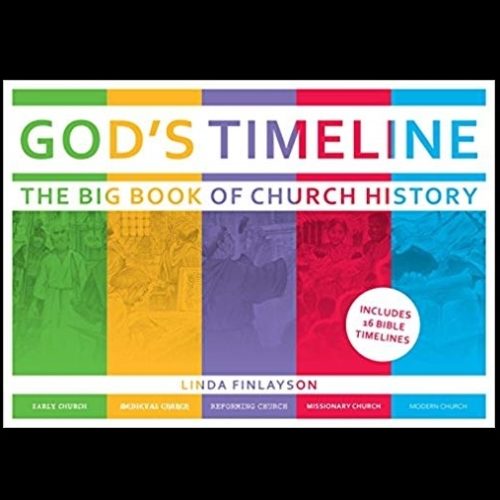It has been said that the trouble with studying history is its literature is written by historians for historians. There are some fine exceptions to this observation, but a considerable portion of historical writing for adults, particularly church history titles, is composed for academics. The average person hoping to learn about an individual or a significant movement might pick up a book on their subject, read the first few pages, and then abandon history because it is believed to be too difficult to understand. In the case of readers that are children, clear historical writing is essential and accurate information is just as important for young ones as for adults. Linda Finlayson has contributed well-written titles that include among others, Wielding the Sword: Preachers and Teachers of God’s Word, 2014, Mary of Orange: At the Mercy of Kings, 2012, and Adventure and Faith, 2009. Her current book, God’s Timeline: The Big Book of Church History, Christian Focus, 2018, is a chronologically segmented survey of church history from its apostolic beginnings into the current century.
As can be seen in the image of the book’s cover, color plays an important role in the author’s presentation. There are five parts organizing the book with each having its own distinctive hue—The Early Church (green), Medieval Church (orange), Reforming Church (purple), Missionary Church (red), and Modern Church (blue). Each of the parts contains brief portions of text concerning subjects within the era, numerous illustrations, and a timeline to organize the relevant publications, people, events, places, and movements of the time. The first events recounted are the death and resurrection of Christ; the last entry is publication of the English Standard Version of the Bible in 2008. Some of the subjects addressed by the author include the Crusades, ancient church councils, the division of the church into separate eastern and western bodies, Bible translation, the five solas of the Reformation, missions, and the Bible’s relationship to science. A nice map of Paul’s missionary journeys is included to illustrate the dramatic growth of the church during his ministry. To set past church events in their general history context, the timelines include selected events from general history such as Rome’s fall, the Battle of Tours and the Thirty Years War, publication of Darwin’s On the Origin of the Species¸ and both World Wars. The title of one topic in the book particularly drew my attention, “The Long-Haired King.” At the end of the volume is a folded sheet which condenses the timelines included in each of the five parts into one that can be removed for a handy reference tool.
Presbyterian and Reformed Christians often speak of catechizing using the question-and-answer formats provided by the Westminster Assembly, or the Heidelberg Catechism, but it would also be beneficial to train children in other areas including church history. Linda Finlayson’s God’s Timeline provides a chronological framework for the study of church history and her other titles expand particular points on the line with additional information that can be used to teach children about the history of their churches.
Several years ago an elderly minister told me that during his years of preaching he dedicated one Lord’s Day morning each month to delivering a sermon specifically composed for children, however, he presented it to the entire congregation. He mentioned that as worshippers exited the church and spoke with him after such a sermon he received more comments of appreciation on those Sundays than the others. Could it be that the reason congregants were appreciative was because his other sermons were over their heads and the child-directed messages were the only ones they could understand? Historical writing, just as sermons, should be written with a sense of the abilities and knowledge of those who will be its readers. Linda Finlayson’s God’s Timeline is a lovely, informative, and clearly written book designed for children, but their parents may also find it a helpful resource for a quick answer to a church history question.
BARRY WAUGH





